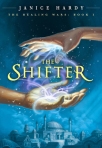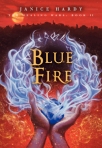 Writers In The Storm is delighted to have Janice Hardy back. We love her and the fabulous writing resources on her blog, The Other Side of the Story.
Writers In The Storm is delighted to have Janice Hardy back. We love her and the fabulous writing resources on her blog, The Other Side of the Story.
***********************
Decades ago, a detached, omniscient point of view was all the rage. Readers wanted to be told a story, so the stories read as if someone was indeed telling them. That style faded as readers sought a more immersive read, and tight points of view became popular.
Regardless of who the narrator is, that’s the person the reader experiences the novel through. A tight first person narrator, an omniscient third, a limited third, it’s all filtered through somebody’s eyes. Sometimes this filter is invisible and the reader doesn’t feel any distance between her and the point of view (POV) character. Other times the filters are obvious and the reader feels the wall between her and the characters. One style looks through the eyes of the POV, the other looks at the POV.
What adds this layer?
Filter words.
Filter words distance the reader from the POV character. They remind readers they’re reading, explain things that are obvious, and often lead a writer into telling. Even worse, filter words are frequently found with their passive, telling cousins, pushing the reader even further away.
If you’re after a tighter and more immersive POV experience, you might try looking for and eliminating these filter words.
Redundant Filter Words
The easiest fix is to get rid of words like, saw, heard, felt, knew, watched, and looked. What makes these words feel detached is that they’re explaining that a character saw or heard something, and then the narrative goes right ahead and shows it anyway. POV characters by definition are relaying everything they sense, say, and think. If it’s described, readers know the character experienced it in some way. It’s like saying, I’m going to look at something, and now I’m telling you what I looked at.
Let’s look at some examples:
Lisa wandered through the field and saw three crows sitting on the fence. Their black feathers glistened in the morning sunshine. She heard them caw the way crows do, and watched them take flight and soar across the bright, blue sky.
I could hear cars whooshing past. The sound of horns blared against my ears, muffled by the morning fog. It felt cold and clammy, sticking to my skin like a layer of wet cloth. It smelled musty, though I knew fog couldn’t possibly be musty.
Notice the extra layer. The character is relaying information in a detached, after the fact, watching-me-do-this tone. There’s a feeling of an outside person describing what the character sees and hears rather than experiencing the same things through that character’s senses.
Look at these same paragraphs without the filter words:
Lisa wandered through the field. Three crows sat on the fence, their black feathers glistening in the morning sunshine. They cawed the way crows do, then took flight and soared across the bright, blue sky.
Cars whooshed past, their blaring horns muffled by the morning fog. It lay cold and clammy against my skin like wet cloth. Musty, though fog couldn’t possibly be musty.
Now the POV character is describing what they experience without telling the reader that they’re looking or hearing or smelling. The reader feels closer to the POV, and can imagine themselves in the story instead of watching the story from afar.
Revising to eliminate filter words is an easy way to achieve a tighter POV, and even fix any told prose in the process.
Do you prefer a tight or a distant point of view? Why? What about it captures you as a reader?
BIO:
Janice Hardy always wondered about the darker side of healing. For her fantasy trilogy THE HEALING WARS, she tapped into her own dark side to create a world where healing was dangerous, and those with the best intentions often made the worst choices. Her books include THE SHIFTER, and BLUE FIRE. DARKFALL, from Balzer+Bray/Harper Collins. She lives in Georgia with her husband, three cats and one very nervous freshwater eel. You can visit her online at www.janicehardy.com, chat with her about writing on her blog, The Other Side of the Story, or find her on Twitter @Janice_Hardy.
Links:




Thank you, thank you, thank you! What a difference! I’m adding the filter words to my list of search terms I use for editing.
Glad I could help! You’ll be surprised how quickly you’ll start stopping yourself from using them when you’re writing.
Great tips! Your example illustrated your point nicely. Thanks!!!!
Most welcome! I have so much fun with the examples.
Thank you for giving me an efficient critiquing tool. Instinctivly I leave those filter words out, or delete them if they’ve crept into a first draft, but they jump out at me when I critique or copyedit other writers, and now I know how to explain why they weaken the writing.
Ooo extra bonus 🙂 Very nice.
Oops! Instinctively, with an e.
My crit partner recently pointed this flaw out to me. I prefer a tight POV because it keeps me living vicariously through the character. Visceral reactions? They’re supposed to be the character’s immediate, unconscious response to external motivation. That zing before thought and action kick in. I had fillers there; author intrusion defined.
Mega thanks for the list of filler words. Gaah! Could my search-and-destroy list grow longer?
I’m also a fan of tight POVs. And search and destroy lists 🙂 Mine keeps growing and growing, so I think they eventually take on a life of their own. Though I have noticed that eventually I stop finding any of some words and I can take them off.
Useful. Thanks.
Pingback: Writing and learning and procrastinating « Pen 'n' Tonic
Great post, Janice! Some of those words were already on my “hit list” but I’ve added the others. 🙂
Thanks! And thanks so much for having me here today. I’ve been a fan of you guys for a long time.
I work hard to have a tight point of view, but filter words still creep in. It’s one of those habits that is hard to break. Great reminder, Janice!
They really are. Once in a while I catch myself slipping one in, too. But that’s what revisions are for, right? 🙂
This was the best, easiest thing I’ve ever read on POV. So many writers struggle with “show, don’t tell.” It seems like it should be such an easy concept, and yet it’s one of the hardest a writer will ever have to master.
Great post. I’ve linked it in my livejournal, and on FB.
Aw, thanks so much! Both of those drove me crazy when I was starting out. I knew what I was supposed to do, but no one ever told me how. I dedicated my whole blog to showing the how 🙂 And figuring out tricks to give writers something to apply to help them figure it all out
Great advice with a sound example. I’m going to read my work hunting for filter words.
Fingers crossed you don’t find any 🙂
POV is always a tricky thing and, as a reader, I get annoyed when an author falls out of the POV the book started with (and not purposefully). I like the unfiltered versions much better because they seem more active and I am more able to lose myself in the story.
The rub for the writer, though, is how to maintain first-person POV when other characters motives must be revealed. That person can’t know what the other is thinking or even doing if they aren’t present in the same scene. I guess that’s why I’ve seen many writer’s switch POV from chapter to chapter–or even within chapters (section to section). Continuity becomes the issue then.
So many things to think about when trying to write well, eh?
Lorna, I love first person (to read and write), and for me, judgement words come into play to help show other characters motives. If the POV is assuming/guessing/ judging the actions, it gets the idea across and still stays in a tight POV. Very handy.
Yes, that would be true. Thanks for pointing that out!
If and when it is really necessary to change POV within a chapter, two techniques used together will help the reader. First, use a line space (marked by the hash mark or an asterisk or such). Second, start the new section with a sentence that clearly shows who has the new POV. Switching POV from one chapter too the next can be clarified by the chapter title, and again by an initial first sentence that clarifies the POV.
What kind of a first sentence do you suggest? Can you give an example?
And thanks for the further clarification!
I’m sure Jody will have examples on how she does it, but I typically use the POV’s name, and something that makes it clear the reader in in that person’s head.
Bob rubbed his eyes and sighed. *This was such a bad idea.*
Or if it’s dual first person, I’ll use the name of the *other* POV to show I’m *not* in their head.
I wasn’t sure if Bob approved, but so what. It was a good plan.
Good examples. They help. Thanks!
Janice’s examples are excellent.
After I finish a scene, I highlight words I tend to over use—was, but, knew, saw, etc.—go back and try to take most of them out. What did we do before Word?
Thanks for a great post.
Thanks! I have no idea. I’d be lost without my word processor 🙂 Back to when I used an actual typewriter, I think I wrote much slower. Of course, I was also much younger, so that might played a role, hehe.
Thank you for this great post. Working in DPOV is a challenge on every level. It takes energy. Thanks so much for making it a little easier! : )
Glad I could help 🙂 It’s my favorite, so I want more great books out there that use it 🙂
Great, great post!!! I am saving this one.
Janice, you know, I started reading this, thinking, “Oh, this will be a good refresher.” Um. No.
Looked? OMG, you don’t want to know how many iterations I have of that word. I’m writing these on a post it, and it’s going on my screen. Your examples made it SO clear!
Awesome. Thanks for the lesson!
LOL Happy to be of service 🙂 My first drafts have a lot of looked actually. They get cut on the second pass. Same with smiled, frown, and shrugged. Major placeholder words for me 🙂
I’ve worked hard to remove those filter words in my YA. It’s first person with a limited cast so I didn’t have too much trouble with keeping the POV consistent.
However, I just returned to a MG I’d started for 2011 NaNo and have found that in adding some fun quirkiness, an omnicient narrator’s voice comes through strongly at times. I’ve read other stories like this but wonder if this is something I should be avoiding?
Thanks (and great to find this site through Janice’s!)
If that’s how it’s coming out, go with it. MG tends to be a little more detached because younger readers don’t always get the subtext. You see a lot of omniscient in MG, and I think kids that age are accustomed to being told a story (read to at bedtime), so it’s a nice bridge to older, tighter POV books. As the saying goes, whatever works, works, and if that’s working for this story, embrace it.
Thanks, this gives me a term for something I’d figured out more or less instinctively, but didn’t know what to call it. You might get a laugh out of this: I started eliminating these words because I wanted to shorten my word count, and they seemed the most redundant and easiest to cut! Never thought about in terms of improving the writing itself.
Looking for words that can be cut often does make for leaner, meaner, more powerful prose. Sometimes, just because I don’t like the lonesome look of a widow (a word by itself at the end of a paragraph or on the start of a new page), I look again at its sentence, or paragraph, I delete the extraneous, and then the whole thing sounds better.
Too funny. Good instincts, though. 🙂
Great post Janice. First time I’ve heard these called filter words. 🙂 They are truly are excess fat we don’t need. I think we all to do this without even knowing it!
I think that’s the “official” term for them, hehe. I imagine the closer your POV the less someone would use them.
Such good advice! I’m reblogging soon. Tweeted.
Thanks!
great examples! I’ll be going through my work with a renewed eye and watching for those nasty filters 🙂
Good luck! Maybe they be few and far between 🙂
Reblogged this on Rakes Rogues and Romance and commented:
Happy Saturday! This will be one of my guides today! What will you be doing?
Thanks for a great post. I’m going to have to take another look at my WIP.
Most welcome, and best of luck !
Wonderful advice which also makes me go slightly pale and want to re-open the file for that latest short story of mine and edit…fast! 🙂
Don’t worry! Even if you find some, take heart in knowing you just improved your writing 🙂 It’s win/win!
I loved you before Janice, but now I L.O.V.E. you! I was using filter words without realizing it, but whenever I read them in other’s works I can spot them and they bugged me. Now I know why. Today will be a filter word evacuation day. Thank you!
Thanks so much! Hope you clipped those filters out of your work yesterday 🙂
This is my year to focus completely on honing my craft. This seems such a fundamental concept, yet I’ve missed it completely. I don’t even know, offhand, if I’ve got this right or not, it’s so new to me. I think I’ll risk checking my two works in progress and see how I’m doing.
Great goal! It goes hand in hand with point of view, so you’d probably benefit most if you worked on those together (whenever POV comes up in your studies). There’s so much to learn with writing, and you’re smart to take a year to work on it. That’ll give you time to take it at a manageable pace.
Pingback: An Easy Fix for a Tighter Point of View | The Funnily Enough | Scoop.it
A few months ago, a writer in my novel bootcamp class made these fixes to my writing. With the corrections, my writing is crisper and as you say tighter. So much better. In the novel bootcamp class I am in now, I make these corrections to other authors’ wip. They love the corrections and effects of them as well. Great topic. Thanks.
That’s something I really love about writers. We’re always there to help other writers and share what we’ve learned 🙂 Hope your bootcamp class is just as helpful this time!
Zowie! You weren’t kidding when you said “easy fix.” This will be a snap to take care of in my rewriting stage. Thanks! 🙂
Most welcome!
Pingback: An Easy Fix for a Tighter Point of View | Hunted & Gathered | Scoop.it
Pingback: I thought I knew Point of View « Ruth Roberts
Pingback: Link Feast For Writers, vol. 39 | Reetta Raitanen's Blog
Great advice. Something I’m working on. I really appreciated your 1st person example as the WIP I’m editing is 1st person and people don’t talk about it as often. It really makes the story feel more immediate.
I love first person for exactly that reason. I use it a lot for examples on my blog as well. It’s more common in YA (which I write) so that’s probably why 🙂
Pingback: Thirsty Thursday Blog Round-up - Writing, Reading, and Life
Reblogged this on Ella Quinn ~ Author.
Ella thanks for reblogging I missed this post and i needed it. 🙂
Thanks for the examples! So many articles about filtering give different examples instead of the same scenario. I really appreciate it1
Glad it was helpful! That frustrates me about examples, too, so I try to use ones where someone can (hopefully!) see the difference. Sometimes it’s hard to see why something reads differently even when you can tell it does.
Pingback: Sexy Saturday Round -Up « Lady Smut
Pingback: I need some help with something. Got a minute? | Jennifer M Eaton